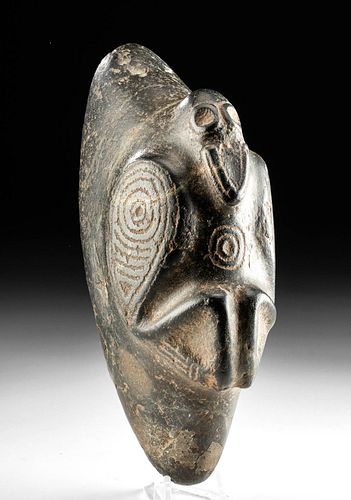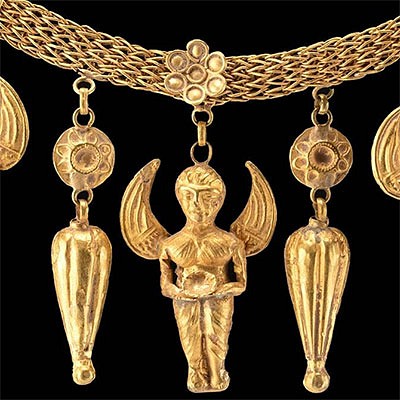Taino Stone Zemi Figure
Lot 125
About Seller
Artemis Fine Arts
686 S Taylor Ave, Ste 106
Louisville, CO 80027
United States
Selling antiquities, ancient and ethnographic art online since 1993, Artemis Gallery specializes in Classical Antiquities (Egyptian, Greek, Roman, Near Eastern), Asian, Pre-Columbian, African / Tribal / Oceanographic art. Our extensive inventory includes pottery, stone, metal, wood, glass and textil...Read more
Estimate:
$2,000 - $3,000
Absentee vs Live bid
Two ways to bid:
- Leave a max absentee bid and the platform will bid on your behalf up to your maximum bid during the live auction.
- Bid live during the auction and your bids will be submitted real-time to the auctioneer.
Bid Increments
| Price | Bid Increment |
|---|---|
| $0 | $25 |
| $300 | $50 |
| $1,000 | $100 |
| $2,000 | $250 |
| $5,000 | $500 |
| $10,000 | $1,000 |
| $20,000 | $2,500 |
| $50,000 | $5,000 |
| $100,000 | $10,000 |
| $200,000 | $20,000 |
About Auction
By Artemis Fine Arts
Dec 3, 2020
Set Reminder
2020-12-03 10:00:00
2020-12-03 10:00:00
America/New_York
Bidsquare
Bidsquare : Fine Antiquities, Ethnographic & Fine Art
https://www.bidsquare.com/auctions/artemis-gallery/fine-antiquities-ethnographic-fine-art-6119
Features classical antiquities, ancient and ethnographic art from cultures encompassing the globe. Egyptian, Greek, Roman, Etruscan, Near Eastern, Asian, Pre-Columbian, Native American, African / Tribal, Oceanic, Spanish Colonial, Russian, Fine Art, so much more! All legally acquired, legal to sell. Artemis Fine Arts info@artemisfinearts.com
Features classical antiquities, ancient and ethnographic art from cultures encompassing the globe. Egyptian, Greek, Roman, Etruscan, Near Eastern, Asian, Pre-Columbian, Native American, African / Tribal, Oceanic, Spanish Colonial, Russian, Fine Art, so much more! All legally acquired, legal to sell. Artemis Fine Arts info@artemisfinearts.com
- Lot Description
Pre-Columbian, Caribbean, Taino, ca. 1100 to 1558 CE. A mesmerizing bird Zemi figure carved from a single piece of deep black basalt stone with meticulously pecked and incised imagery - the avian presenting with large circular eyes, a long beak, elegant wings adorned with concentric circles and striations, concentric circles over the chest, and upraised legs. Birds were believed to be helpers for the shaman and shaman priests. Overall, a mesmerizing piece with an impressive aesthetic and spiritual presence that is among the various cult objects associated with the worship of "zemis" - deities, ancestors, or earth spirits revered by the Taino culture. Size: 4.125" L x 3.25" W x 8.5" H (10.5 cm x 8.3 cm x 21.6 cm)
The Zemi (or Cemi) stone, with its characteristic three cardinal points, is a fundamental symbol in the Taino religion. Tainos traditionally name the three points "Yocahu Bagua Maorocoti" - another word for the Creator, Yaya. Zemis like this example are believed to be inhabited by powerful spirits. The uppermost point represents the top of this sacred mountain peak, in the turey (sky) of the four directions, where Yaya - the Creator, whose name means that which has neither beginning nor end and which has no male ancestor or creator - resides. The lower point represents Coabey, the underworld or place of the dead. Here Hupia, the spirit of the dead, resides, and the face of Guayaba, the Chief of Coabey, is represented. Finally, the opposite point represents the land of the living where Goiz, the spirit of living people, resides.
Provenance: private Southern California, USA collection, acquired in the 1970s to mid-1980s
All items legal to buy/sell under U.S. Statute covering cultural patrimony Code 2600, CHAPTER 14, and are guaranteed to be as described or your money back.
A Certificate of Authenticity will accompany all winning bids.
We ship worldwide and handle all shipping in-house for your convenience.
#145809Repair across the right proper side of the face, beak, upper wing, and section behind it. Expected surface wear with nicks, chips, scuffs, and abrasions as shown. Nice pecking marks in recessed areas.Condition
- Shipping Info
-
All shipping is handled in-house for your convenience. Your invoice from Artemis Gallery will include shipping calculation instructions. If in doubt, please inquire BEFORE bidding for estimated shipping costs for individual items.
-
- Buyer's Premium



 EUR
EUR CAD
CAD AUD
AUD GBP
GBP MXN
MXN HKD
HKD CNY
CNY MYR
MYR SEK
SEK SGD
SGD CHF
CHF THB
THB
















